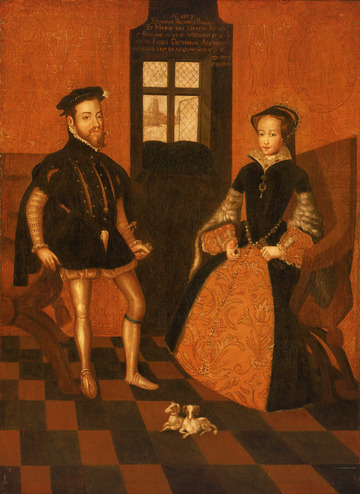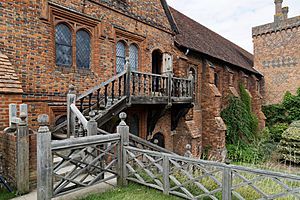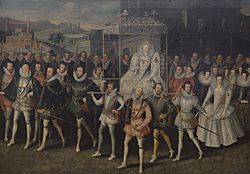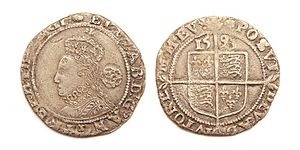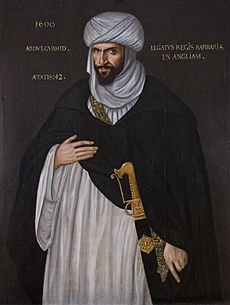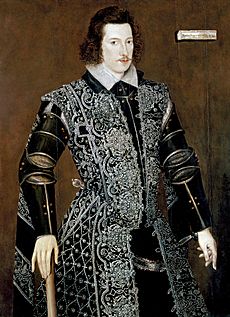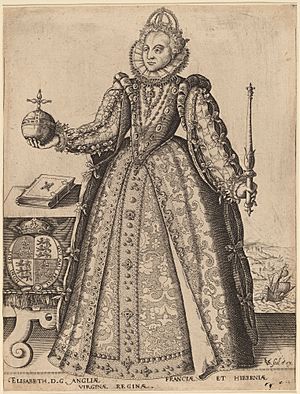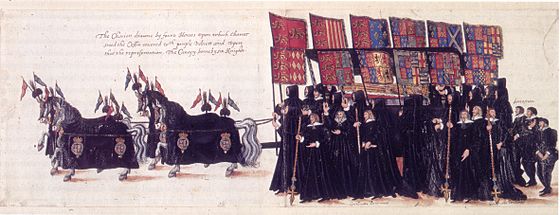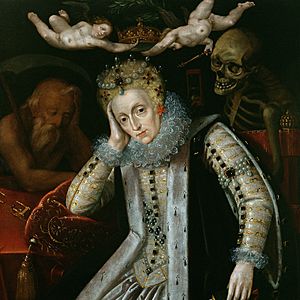Elizabeth I facts for kids
Quick facts for kids Elizabeth I |
|
|---|---|

The "Darnley Portrait", c. 1575
|
|
| Queen of England and Ireland (more...) | |
| Reign | 17 November 1558 – 24 March 1603 |
| Coronation | 15 January 1559 |
| Predecessor | Mary I |
| Successor | James I |
| Born | 7 September 1533 Palace of Placentia, Greenwich, England |
| Died | 24 March 1603 (aged 69) Richmond Palace, Surrey, England |
| Burial | 28 April 1603 Westminster Abbey |
| House | Tudor |
| Father | Henry VIII |
| Mother | Anne Boleyn |
| Religion | Anglicanism |
| Signature | |
Elizabeth I (born 7 September 1533, died 24 March 1603) was the Queen of England and Ireland. She ruled from 17 November 1558 until her death in 1603. Elizabeth was the last ruler from the Tudor family. She is sometimes called the "Virgin Queen" because she never married.
Elizabeth was the daughter of Henry VIII and his second wife, Anne Boleyn. Her mother was executed when Elizabeth was only two years old. For a time, Elizabeth was not considered a rightful heir to the throne. After Henry VIII died, her half-brother Edward VI became king. He tried to prevent his half-sisters, Mary and Elizabeth, from becoming queen.
However, Edward's plan failed, and Mary became queen. During Mary's rule, Elizabeth was even put in prison for almost a year. People thought she might be supporting rebels who were against Mary's Catholic faith. When Mary died in 1558, Elizabeth became queen. She chose wise advisers, like William Cecil.
One of Elizabeth's first big actions was to create the Church of England. She became its "supreme governor." Many people expected her to marry and have children to continue the Tudor family line. But she never did. After her death, her cousin, James VI of Scotland, became King of England. Elizabeth's long reign brought stability to England. It also helped create a strong sense of national identity. Her time as queen is known as the Elizabethan era. It was a time of great English drama, with writers like William Shakespeare. It also saw brave sea explorers like Francis Drake and the famous defeat of the Spanish Armada.
Contents
Elizabeth's Early Life

Elizabeth was born at Greenwich Palace on 7 September 1533. She was named after her grandmothers. She was the second child of Henry VIII to survive infancy. Her mother was Henry's second wife, Anne Boleyn. When Elizabeth was born, she was next in line to the throne. Her older half-sister, Mary, had lost her place. This happened when Henry ended his marriage to Mary's mother, Catherine of Aragon. He wanted a son to be his heir.
Elizabeth was only two years old when her mother, Anne Boleyn, was executed. This happened on 19 May 1536. Elizabeth was then declared illegitimate, meaning she could not inherit the throne. Just eleven days after Anne's death, Henry married Jane Seymour. Jane gave birth to a son, Edward, who became the clear heir. Elizabeth lived in her half-brother's home.
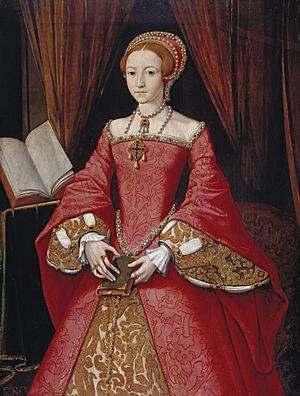
Elizabeth was a very smart child. Her first governess, Margaret Bryan, said she was a "gentle" and "toward" child. Catherine Champernowne, known as Kat Ashley, became her governess in 1537. She taught Elizabeth four languages: French, Dutch, Italian, and Spanish. By 1544, Elizabeth could also write in English and Latin. She even learned Greek.
By age 12, Elizabeth could translate books into Italian, Latin, and French. She gave one of these translations to her father as a gift. Throughout her life, she translated many classical works. By the time her formal education ended in 1550, Elizabeth was one of the most educated women of her time. She was even thought to speak Welsh, Cornish, Scottish, and Irish.
Challenges with Thomas Seymour
When Henry VIII died in 1547, Elizabeth's half-brother, Edward VI, became king at age nine. Henry's widow, Catherine Parr, soon married Thomas Seymour, 1st Baron Seymour of Sudeley. He was Edward VI's uncle. Elizabeth went to live with them in Chelsea.
In 1548, Elizabeth was sent away. After Catherine Parr died, Thomas Seymour wanted to marry Elizabeth. But Elizabeth did not want to marry him. In January 1549, Seymour was arrested. He was accused of planning to take power and marry Elizabeth. Seymour was executed on 20 March 1549.
Mary I's Reign
Edward VI died on 6 July 1553, when he was 15. His will tried to prevent Mary and Elizabeth from becoming queen. Instead, he named Lady Jane Grey as his heir. But Jane's support quickly disappeared. Mary became queen after nine days. On 3 August 1553, Mary rode into London with Elizabeth by her side.
However, their unity did not last. Mary was a strong Catholic. She wanted to end the Protestant faith in England. Elizabeth had to pretend to follow Catholic rules. Mary's popularity dropped when she planned to marry Philip of Spain. Many people in England did not like this. They saw Elizabeth as a hope against Mary's religious policies.
In 1554, a rebellion broke out. Elizabeth was questioned about her role. On 18 March, she was sent to the Tower of London. Elizabeth insisted she was innocent. Even though she likely didn't plot with the rebels, some had tried to involve her. Mary's advisers wanted Elizabeth put on trial. But Elizabeth's supporters convinced Mary to spare her. On 22 May, Elizabeth was moved to Woodstock. She stayed there under house arrest for almost a year. Crowds cheered her as she passed.
By 1555, it was clear Mary would not have a child. Elizabeth's chance to become queen seemed certain. King Philip of Spain, who became king in 1556, started to be friendly with Elizabeth. He saw her as a better ally than Mary, Queen of Scots. Mary had grown up in France and was engaged to the French prince. When Mary I became ill in 1558, Elizabeth was already planning her government. Mary recognized Elizabeth as her heir on 6 November 1558. Elizabeth became queen when Mary died on 17 November.
Becoming Queen
Elizabeth became queen at 25 years old. She told her plans to her council and other important people. They had come to Hatfield to promise their loyalty. As she rode through London before her coronation, people cheered her. They put on plays and speeches, many with Protestant themes. Elizabeth's kind responses made people love her.
On 15 January 1559, Elizabeth was crowned in Westminster Abbey. Her astrologer, John Dee, chose the date. She was presented to the people, with loud music and bells. Even though Elizabeth was welcomed, England was still worried about Catholic threats. People also wondered whom she would marry.
Setting Up the Church

Historians still discuss Elizabeth's personal religious beliefs. She was a Protestant. But she kept some Catholic symbols, like the crucifix. She also didn't emphasize sermons as much as other Protestants.
Elizabeth and her advisers worried about a Catholic attack on England. So, the queen wanted a Protestant solution. This solution would not upset Catholics too much. But it would also meet the wishes of English Protestants. She did not like the Puritans, who wanted big changes. In 1559, Parliament passed laws for a church based on Edward VI's Protestant ideas. The monarch would be its head. But it would keep some Catholic elements, like church clothing.
The House of Commons strongly supported these ideas. But the bill faced problems in the House of Lords. This was especially true from the bishops. Elizabeth was lucky that many bishop positions were empty. This allowed her supporters to outvote the bishops. Elizabeth had to accept the title of Supreme Governor of the Church of England. She could not use the title "Supreme Head." Many people thought a woman should not have that title.
The new Act of Supremacy became law on 8 May 1559. All public officials had to promise loyalty to the queen as supreme governor. If they refused, they would lose their jobs. Laws against heresy were removed. This was to prevent the persecution that happened under Mary. At the same time, a new Act of Uniformity was passed. It made going to church and using an updated Book of Common Prayer required. But the punishments for not following these rules were not very harsh.
The Marriage Question
From the start of Elizabeth's reign, everyone expected her to marry. Many people offered to marry her. But she never married and had no children. The reasons for this are not fully clear. She thought about different partners until she was about 50. Her last serious courtship was with Francis, Duke of Anjou. He was 22 years younger than her.
Marrying could have given her an heir. But it could also cause political problems or even a rebellion. Her sister Mary had faced problems by marrying Philip II of Spain.
Robert Dudley
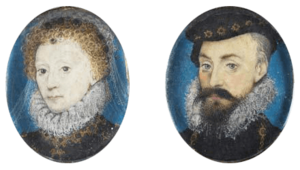
In 1559, it seemed Elizabeth was in love with her childhood friend, Robert Dudley. His wife died in September 1560. She fell down stairs. Even though the investigation said it was an accident, many thought Dudley had caused her death. They believed he wanted to marry the queen. Elizabeth thought about marrying Dudley for some time. But William Cecil and other important people strongly disagreed. There were even rumors that nobles would rebel if the marriage happened.
Robert Dudley remained a possible husband for nearly ten more years. Elizabeth was very jealous of him, even when she no longer planned to marry him. She made Dudley an Earl in 1564. In 1578, he married Lettice Knollys. Elizabeth was very angry about this and disliked Lettice for life. Still, Dudley was always very important in Elizabeth's life. He died in 1588. After Elizabeth's death, a letter from him was found among her personal items. She had written "his last letter" on it.
Foreign Suitors
Marriage talks were a big part of Elizabeth's foreign policy. She turned down Philip of Spain, her half-sister's widower, in 1559. But for several years, she considered marrying King Eric XIV of Sweden. She also seriously talked about marrying Philip's cousin, Charles II, Archduke of Austria.

Later, Elizabeth considered marrying two French princes. First, Henry, Duke of Anjou, and then his brother, Francis, Duke of Anjou. This last idea was linked to a plan to fight Spain in the Netherlands. Elizabeth seemed to take this courtship seriously. She even wore a frog-shaped earring that Francis sent her.
In 1563, Elizabeth told a visitor: "If I follow my nature, I would rather be a poor woman and single, than a queen and married." Later that year, Elizabeth got smallpox. This made the question of who would rule next a big issue in Parliament. Members urged the queen to marry or name an heir. They wanted to prevent a civil war after her death. She refused to do either.
By 1570, important government figures privately accepted that Elizabeth would never marry. Her silence helped her political safety. She knew that if she named an heir, her throne could be in danger. She remembered how others had used her as a focus for plots against Mary I.
Mary, Queen of Scots
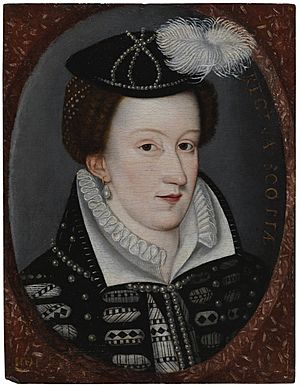
Elizabeth's first goal for Scotland was to remove the French presence there. She worried that the French planned to invade England. They might put her Catholic cousin, Mary, Queen of Scots, on the English throne. Many people thought Mary was the rightful heir to England. Mary was the granddaughter of Henry VIII's older sister.
Elizabeth sent an army to Scotland to help Protestant rebels. The English campaign was not perfect. But the Treaty of Edinburgh in July 1560 removed the French threat. When Mary returned to Scotland in 1561, the country had a Protestant church. It was run by Protestant nobles supported by Elizabeth. Mary refused to agree to the treaty.
In 1563, Elizabeth suggested Robert Dudley as a husband for Mary. Neither Mary nor Dudley liked the idea. In 1565, Mary married Henry Stuart, Lord Darnley. He also had a claim to the English throne. This marriage was one of Mary's mistakes. Darnley quickly became unpopular. He was murdered in February 1567. People believed James Hepburn, 4th Earl of Bothwell led the plot. Soon after, Mary married Bothwell. This made people suspect she was involved in Darnley's murder.
These events quickly led to Mary's defeat. She was imprisoned in Lochleven Castle. Scottish lords forced her to give up her crown. Her son, James VI, became king. James was born in June 1566. He was raised as a Protestant. Mary escaped in 1568. After a defeat at Langside, she fled to England. She had hoped Elizabeth would help her.
Elizabeth wanted to help another queen. But she and her council decided to be careful. They did not want to send Mary back to Scotland with an English army. They also did not want to send her to France, where she could become an enemy. So, they kept her imprisoned in England for 19 years.
Catholic Threat

Mary soon became a symbol for rebellion. In 1569, a big Catholic uprising happened in the North. The goal was to free Mary, marry her to Thomas Howard, 4th Duke of Norfolk, and make her Queen of England. After the rebels were defeated, Elizabeth ordered the execution of over 750 of them.
In 1570, Pope Pius V issued a special order called Regnans in Excelsis. It said Elizabeth was not the true Queen and was a heretic. It told all Catholics they did not have to obey her. Catholics who obeyed Elizabeth were threatened with being removed from the Church. This order led Parliament to pass laws against Catholics. But Elizabeth made these laws less harsh. In 1581, it became treason to try to convert English people to Catholicism to make them disloyal to Elizabeth. This crime carried the death penalty.
Regnans in Excelsis gave English Catholics a strong reason to see Mary as the rightful queen. Elizabeth's spymaster, Sir Francis Walsingham, found many plots against Elizabeth. These plots often involved Mary. From the Ridolfi Plot in 1571 to the Babington Plot in 1586, Walsingham gathered evidence against Mary.
At first, Elizabeth did not want to execute Mary. But by late 1586, she was convinced to allow Mary's trial and execution. This was based on letters from the Babington Plot. Elizabeth's announcement said Mary had planned things that would harm and kill the queen. On 8 February 1587, Mary was beheaded at Fotheringhay Castle. After the execution, Elizabeth said she did not mean for the order to be sent. She blamed her secretary, William Davison. Historians still debate if Elizabeth truly regretted it or wanted to delay the execution.
Wars and Trade
Elizabeth's foreign policy was mostly about defending England. One exception was the English occupation of Le Havre in France from 1562 to 1563. This failed. Elizabeth had hoped to trade Le Havre for Calais, which England lost in 1558. Elizabeth mostly used her navy for aggressive actions. This helped in the war against Spain, which was mostly fought at sea. She made Francis Drake a knight after he sailed around the world. Drake became famous for attacking Spanish ports and ships. English sailors like Drake sometimes acted like pirates. The queen had little control over them.
Netherlands
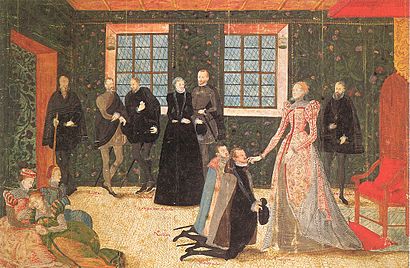
After losing Le Havre, Elizabeth avoided sending armies to Europe until 1585. Then, she sent an English army to help the Protestant Dutch rebels fight Philip II of Spain. This happened after Elizabeth's allies died in 1584. Also, Spanish forces were taking over Dutch towns. In December 1584, Philip II and the French Catholic League formed an alliance. This made Spain stronger in the Netherlands. It also put England at risk of invasion.
The siege of Antwerp in 1585 forced England and the Dutch to act. The result was the Treaty of Nonsuch in August 1585. Elizabeth promised military support to the Dutch. This treaty started the Anglo-Spanish War. It lasted until 1604.
Elizabeth's former suitor, the Earl of Leicester, led the English army. Elizabeth did not fully support this plan. She wanted to help the Dutch but also have secret peace talks with Spain. Leicester wanted to fight an active war. Elizabeth wanted him "to avoid at all costs any decisive action." Leicester angered Elizabeth by becoming Governor-General of the Dutch. Elizabeth saw this as a trick to make her take control of the Netherlands. She had always refused this.
Elizabeth ordered her messenger to read her letters of disapproval publicly to the Dutch Council. Leicester had to stand nearby. This public embarrassment, along with her secret talks with Spain, hurt Leicester's standing with the Dutch. The military campaign struggled. Elizabeth often refused to send money for her starving soldiers. Leicester's own weaknesses and Dutch political problems also led to the campaign's failure. Leicester finally quit his command in December 1587.
Spanish Armada
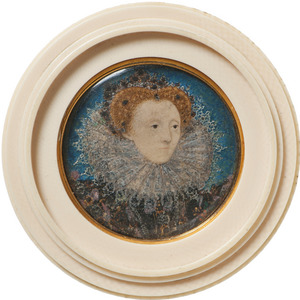
Meanwhile, Sir Francis Drake had attacked Spanish ports and ships in the Caribbean in 1585 and 1586. In 1587, he successfully raided Cádiz. He destroyed Spanish warships meant for an invasion of England. Philip II had decided to take the war to England.
On 12 July 1588, the Spanish Armada, a huge fleet of ships, sailed towards England. It planned to carry a Spanish invasion force from the Netherlands to England. But bad luck and an attack by English fire ships on 29 July defeated the Armada. The fire ships scattered the Spanish ships. The Armada struggled back to Spain in broken pieces. Many ships were lost off the coast of Ireland.
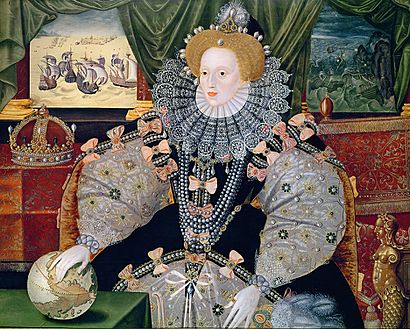
English militias gathered to defend the country. The Earl of Leicester led them. Leicester invited Elizabeth to inspect her troops at Tilbury in Essex on 8 August. When no invasion came, the nation celebrated. Elizabeth's parade to a thanksgiving service was as grand as her coronation. The defeat of the Armada was a huge victory for Elizabeth and Protestant England. English people saw it as a sign of God's favor.
However, this victory did not end the war. The war continued and often favored Spain. Spain still controlled parts of the Netherlands. The threat of invasion remained. In 1589, the year after the Spanish Armada, Elizabeth sent the "English Armada" to Spain. This fleet of 150 ships and 23,375 men was led by Sir Francis Drake and Sir John Norreys. But the English fleet suffered a terrible defeat. Thousands died, and many ships were lost. England lost the advantage it had gained. Spain's navy grew stronger.
France
When the Protestant Henry IV became King of France in 1589, Elizabeth sent him military help. This was her first time sending troops to France since 1563. Henry's claim to the throne was strongly challenged by Catholics and Philip II. Elizabeth worried Spain would take control of French ports along the English Channel.
However, the English campaigns in France were messy and ineffective. Peregrine Bertie, 13th Baron Willoughby de Eresby, ignored Elizabeth's orders. He wandered northern France with 4,000 men and achieved little. He returned in disarray, having lost half his troops. In 1591, John Norreys's campaign in Brittany was even worse. Elizabeth was unwilling to send enough supplies and reinforcements. Norreys went to London to ask for more support. While he was gone, a Catholic army almost destroyed his remaining troops.
In July, Elizabeth sent another force under Robert Devereux, 2nd Earl of Essex, to help Henry IV besiege Rouen. This also failed. Essex did nothing and returned home in January 1592. Henry gave up the siege in April. Elizabeth often lacked control over her commanders once they were abroad. She wrote about Essex, "Where he is, or what he doth, or what he is to do, we are ignorant."
Ireland
Ireland was one of Elizabeth's kingdoms. But she faced a hostile Irish population. They were Catholic and often rebelled against her. They were willing to plot with her enemies. Elizabeth's goal was to give land to her courtiers. She also wanted to stop rebels from giving Spain a base to attack England.
During a series of uprisings, Crown forces used harsh tactics. They burned land and killed many people. During a revolt in Munster in 1582, about 30,000 Irish people starved to death. Elizabeth told her commanders to treat the Irish well. But she and her commanders showed no regret when force was used.
From 1594 to 1603, Elizabeth faced her biggest challenge in Ireland. This was the Nine Years' War. It was a revolt led by Hugh O'Neill, Earl of Tyrone. Spain supported him. In 1599, Elizabeth sent Robert Devereux, 2nd Earl of Essex, to stop the revolt. But he made little progress. He returned to England against her orders. Charles Blount, 8th Baron Mountjoy, replaced him. It took Mountjoy three years to defeat the rebels. O'Neill finally surrendered in 1603, just a few days after Elizabeth's death. Soon after, England and Spain signed a peace treaty.
Russia
Elizabeth continued to have good relations with Russia. These relations started with her half-brother, Edward VI. She often wrote friendly letters to Tsar Ivan the Terrible. But the Tsar was sometimes annoyed that she focused on trade. He wanted a military alliance. Ivan even proposed marriage to her once. Later, he asked if he could have a safe place in England if his rule was in danger.
English merchant Anthony Jenkinson became Elizabeth's special ambassador to Tsar Ivan's court. When Ivan died in 1584, his son Feodor I became Tsar. Feodor did not want to give England special trading rights. He opened his kingdom to all foreigners. Elizabeth sent a new ambassador to ask Feodor to change his mind. But the talks failed. Elizabeth continued to write to Feodor. She proposed an alliance, which she had refused to do for Ivan. But Feodor turned her down.
Muslim States
England developed trade and diplomatic relations with the Barbary states (North Africa) during Elizabeth's rule. England traded with Morocco against Spain's wishes. They sold weapons and metal for Moroccan sugar, despite a papal ban. In 1600, Abd el-Ouahed ben Messaoud, an ambassador from Morocco, visited England. He wanted to make an alliance against Spain. Elizabeth agreed to sell weapons to Morocco. She and the Moroccan ruler talked about a joint attack on Spain. But these talks did not lead to a firm agreement. Both rulers died within two years.
Diplomatic relations also started with the Ottoman Empire. This happened when the Levant Company was formed. The first English ambassador was sent in 1578. A trade treaty was signed in 1580. Many messengers were sent between England and the Ottoman Empire. Elizabeth and Sultan Murad III exchanged letters. Murad thought that Islam and Protestantism were more similar to each other than to Catholicism. He suggested an alliance between England and the Ottoman Empire. England sold tin and lead (for cannons) and weapons to the Ottoman Empire. Elizabeth even discussed joint military actions with Murad III when the war with Spain started in 1585.
America
In 1583, Sir Humphrey Gilbert sailed west to start a colony in Newfoundland. He never returned to England. Gilbert's half-brother, Sir Walter Raleigh, explored the Atlantic Coast. He claimed the land of Virginia. This name might have honored Elizabeth, the "Virgin Queen." This area was much larger than the current state of Virginia.
In 1585, Raleigh returned to Virginia with a small group of people. They landed on Roanoke Island. After the first colony failed, Raleigh sent another group. John White was in charge. When Raleigh returned in 1590, there was no sign of the Roanoke Colony. But it was the first English settlement in North America.
East India Company
The East India Company was created to trade in the Indian Ocean and China. Queen Elizabeth gave it a special permission on 31 December 1600. For 15 years, the company had a monopoly on English trade. This meant they were the only ones allowed to trade with countries east of the Cape of Good Hope and west of the Straits of Magellan. Sir James Lancaster led the first trip in 1601. The company later controlled a large part of world trade and much land in India.
Later Years
After the defeat of the Spanish Armada in 1588, Elizabeth faced new problems. These lasted until the end of her reign. The wars with Spain and in Ireland continued. Taxes became heavier. The economy suffered from bad harvests and war costs. Prices went up, and people's living standards went down. During this time, the repression of Catholics increased. Elizabeth allowed groups to question and watch Catholic households in 1591. To keep up the appearance of peace, she used spies and propaganda more. In her last years, growing criticism showed that people's affection for her was decreasing.
One reason for these changes was the new people in Elizabeth's government. Many important politicians had died around 1590. These included the Earl of Leicester, Sir Francis Walsingham, and Sir Christopher Hatton. Now, there was a lot of fighting between different groups in the government. A bitter rivalry grew between Robert Devereux, 2nd Earl of Essex, and Robert Cecil. Cecil was the son of Lord Burghley. This struggle for power harmed the kingdom's politics. The queen's own power was weakening. For example, in 1594, her trusted doctor, Dr. Lopez, was wrongly accused of treason by the Earl of Essex. Elizabeth could not stop his execution, even though she was angry and did not believe he was guilty.
In her last years, Elizabeth relied on giving out monopolies. This was a way to reward her courtiers without spending money from Parliament. But this led to high prices and made courtiers rich at the public's expense. This caused widespread anger. It led to protests in Parliament in 1601.
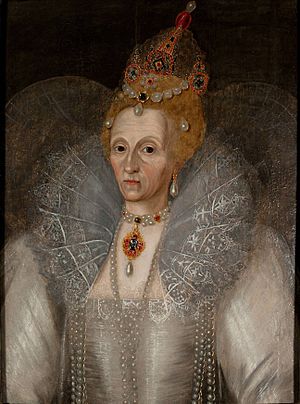
However, this time of economic and political trouble also saw a great flourishing of English literature. Writers like William Shakespeare and Christopher Marlowe became famous. The English theater reached its peak. The idea of a great Elizabethan era comes from the artists, writers, and musicians of her time. They did not get much direct support from the queen.
As Elizabeth got older, her image changed. She was shown as a goddess-like figure. After the Armada, she was called "Gloriana," the forever young queen. Her painted portraits became less realistic. They made her look much younger than she was. In reality, her skin was scarred from smallpox in 1562. She became partly bald and used wigs and makeup. Her love of sweets and fear of dentists led to bad tooth decay. Foreign ambassadors found it hard to understand her speech. One ambassador noted her yellow and missing teeth. But he added that she was "fair and tall and graceful." Sir Walter Raleigh called her "a lady whom time had surprised."
The more Elizabeth's beauty faded, the more her courtiers praised it. Elizabeth enjoyed playing this role. But it is possible that in her last ten years, she started to believe her own performance. She became very fond of the charming but difficult young Earl of Essex. He was Leicester's stepson. He often took liberties with her, and she forgave him. She kept giving him military jobs despite his irresponsible behavior. After Essex left his command in Ireland in 1599, Elizabeth put him under house arrest. The next year, she took away his monopolies. In February 1601, Essex tried to start a rebellion in London. He wanted to capture the queen. But few people supported him. He was beheaded on 25 February. Elizabeth knew that her own mistakes were partly to blame for this.
Death of the Queen
Elizabeth's main adviser, Lord Burghley, died on 4 August 1598. His son, Robert Cecil, took over as the leader of the government. One of his tasks was to prepare for a smooth transfer of power. Since Elizabeth would never name her successor, Robert Cecil had to work in secret. He began secret talks with James VI of Scotland. James had a strong claim to the throne, but it was not officially recognized. Cecil told James to be polite to Elizabeth. This advice worked. James's respectful tone pleased Elizabeth. She may not have openly named James as her heir. But she made her wishes known with clear, though hidden, messages.
The queen's health was good until the autumn of 1602. Then, several friends died, which made her very sad. In February 1603, the death of Catherine Howard, Countess of Nottingham, was a big blow. She was the niece of Elizabeth's close friend. In March, Elizabeth became sick. She was in a deep sadness and sat still for hours. When Robert Cecil told her she must go to bed, she snapped: "Must is not a word to use to princes, little man." She died on 24 March 1603 at Richmond Palace. This was between two and three in the morning. A few hours later, Cecil and the council announced James as King of England.
Elizabeth's coffin was carried down the river at night to Whitehall. It was on a barge lit with torches. At her funeral on 28 April, the coffin was taken to Westminster Abbey. It was on a carriage pulled by four horses.
Elizabeth was buried in Westminster Abbey. Her tomb is shared with her half-sister, Mary I. The Latin words on their tomb mean: "Partners in realm and tomb, here we sleep, Elizabeth and Mary, sisters, in hope of resurrection."
Elizabeth's Legacy
Many of Elizabeth's subjects mourned her death. But others were relieved. Hopes for King James were high at first, but then they went down. By the 1620s, people started to remember Elizabeth fondly again. Elizabeth was praised as a hero for the Protestant cause. She was seen as the ruler of a golden age. James was seen as too friendly with Catholics.
The grand image Elizabeth had created for herself was taken as truth. Her reputation grew. Godfrey Goodman, a bishop, remembered: "When we had experience of a Scottish government, the Queen did seem to revive. Then was her memory much magnified." Elizabeth's reign was seen as a time when the crown, church, and parliament worked well together.
The image of Elizabeth painted by her Protestant admirers in the early 1600s has lasted. Her memory was also revived during the Napoleonic Wars. At that time, England faced the threat of invasion again. In the Victorian era, the legend of Elizabeth was used to support the idea of a powerful British Empire. In the mid-1900s, Elizabeth became a symbol of national resistance to foreign threats. Historians like J. E. Neale and A. L. Rowse saw her reign as a golden age of progress. They also saw the Queen as perfect. They ignored her less pleasant traits or explained them away.
However, recent historians have a more complex view of Elizabeth. Her reign is famous for defeating the Armada. It is also known for successful raids against Spain. But some historians point to military failures on land and sea. In Ireland, Elizabeth's forces won. But their harsh tactics stain her record. Instead of a brave defender of Protestants, she is often seen as cautious in her foreign policies. She gave very little help to Protestants in other countries. She also failed to give her commanders enough money to make a difference abroad.
Elizabeth created an English church that helped shape a national identity. This church still exists today. Those who later praised her as a Protestant hero overlooked her refusal to remove all Catholic practices from the Church of England. Historians note that in her day, strict Protestants saw her church settlement as a compromise. Elizabeth believed that faith was personal. She did not want to "make windows into men's hearts and secret thoughts."
Even though Elizabeth mostly followed a defensive foreign policy, her reign raised England's status abroad. Pope Sixtus V marveled: "She is only a woman, only mistress of half an island, and yet she makes herself feared by Spain, by France, by the Empire, by all." Under Elizabeth, England gained new confidence. Elizabeth was the first Tudor ruler to understand that a monarch needed popular support. She always worked with Parliament and trusted advisers. This was a style of government that her later Stuart rulers failed to follow. Some historians say she was lucky. She believed that God was protecting her. Elizabeth was proud to be "mere English." She trusted in God, honest advice, and the love of her subjects for her rule to succeed.
Family Tree
See also
 In Spanish: Isabel I de Inglaterra para niños
In Spanish: Isabel I de Inglaterra para niños


